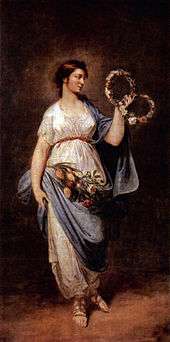Vesna
The vesna or vesnas were mythological female characters associated with youth and springtime in early Slavic mythology, particularly within Croatia,[1] Serbia and Slovenia. Along with her male companion Vesnik, she was associated with rituals conducted in rural areas during springtime.[2] In the nineteenth century, Russian peasants celebrated the return of spring on March 1 by going out to the fields, carrying a clay figure of a lark on a pivot which had been decorated with flowers. They sang songs naming the spring season Vesna.[3] The word "vesna" is still the poetic word for "spring" in the Slovene language,[2] as well as Czech and Slovak. Also, vesna (Russian: весна́) is a Russian word for spring. The month February is sometimes named vesnar in Slovene language.[2]
In Slovene mythology, the beautiful women called "vesnas" lived in palaces atop mountains where they discussed the fate of crops and of human inhabitants. A magical circle around their palaces kept them from leaving the mountain top except during the month of February, when they would travel in wooden carts down to the valley below. Only certain people were capable of hearing them singing. People who snuck up to their mountain palaces might learn their fates, but risked an unpleasant end if they were caught by the vesnas.[2]
The vesna was featured on a Slovenian postage stamp in 2005.[4]
See also
Notes
References
- Abbott, George Frederick (1903). Macedonian Folklore.
